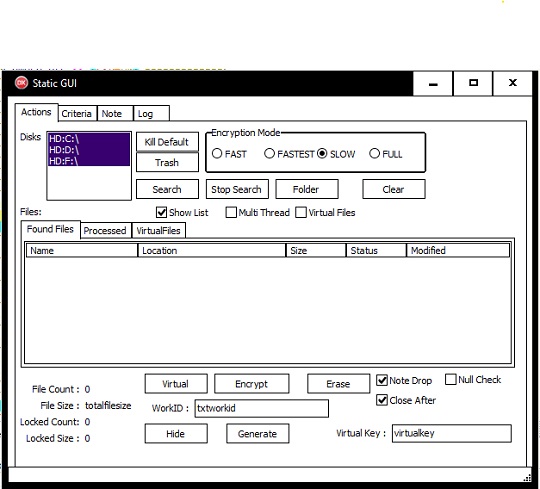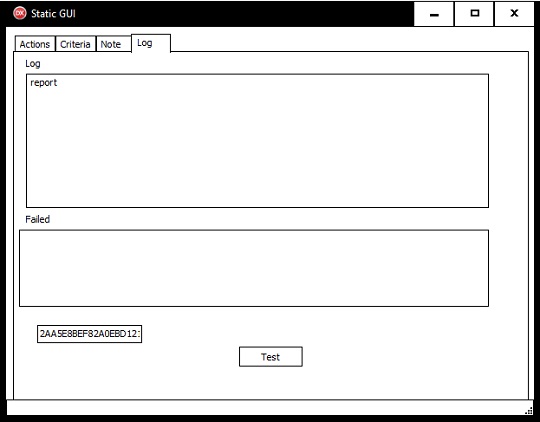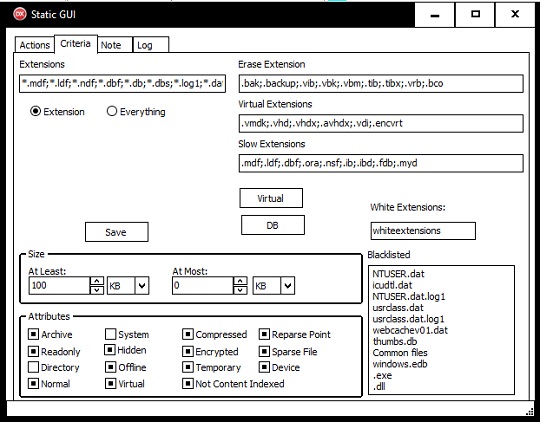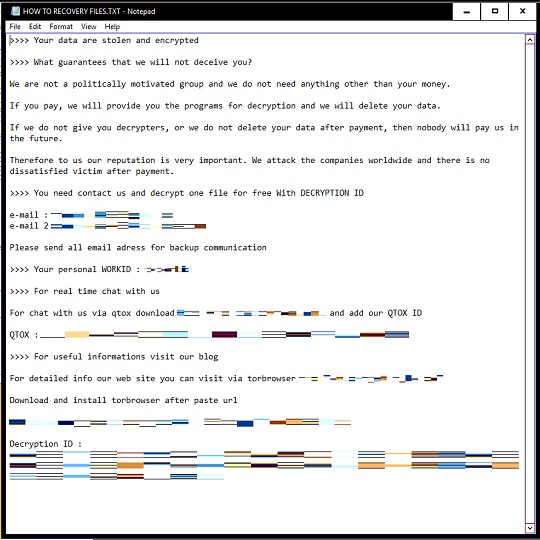Ransom.Win64.ENAMON.THACABD
a variant of Win64/Filecoder.Spacecolon.A trojan (NOD32)
Windows


Threat Type: Ransomware
Destructiveness: No
Encrypted: No
In the wild: Yes
OVERVIEW
This Ransomware arrives on a system as a file dropped by other malware or as a file downloaded unknowingly by users when visiting malicious sites.
It encrypts files with specific file extensions. It drops files as ransom note. It avoids encrypting files with the following file extensions.
TECHNICAL DETAILS
Arrival Details
This Ransomware arrives on a system as a file dropped by other malware or as a file downloaded unknowingly by users when visiting malicious sites.
Installation
This Ransomware drops the following files:
- {Malware File Path}\note.txt → deleted afterwards
- {Malware File Path}\ext.txt → deleted afterwards
- {Malware File Path}\SelfDelete.bat → used to delete itself
- {Encrypted File Path}\DECRYPTION_IDS.TXT→ contains decryption IDs
It adds the following processes:
- "%System%\cmd.exe\" /C "{Malware File Path}\SelfDelete.bat"
(Note: %System% is the Windows system folder, where it usually is C:\Windows\System32 on all Windows operating system versions.)
Process Termination
This Ransomware terminates the following processes if found running in the affected system's memory:
- 105.5.5195.102_104.0.5112.81_chrome_updater.exe
- applicationframehost.exe
- audiodg.exe
- dashost.exe
- dllhost.exe
- fiddler.exe
- googlecrashhandler.exe
- googlecrashhandler64.exe
- googleupdate.exe
- microsoftedgeupdate.exe
- mpcmdrun.exe
- msascui.exe
- mscorsvw.exe
- nissrv.exe
- onedrive.exe
- plugin_host.exe
- processhacker.exe
- procmon.exe
- procmon64.exe
- ptsessionagent.exe
- ptwatchdog.exe
- searchindexer.exe
- setup.exe
- sublime_text.exe
- sysmon64.exe
- tabtip.exe
- tabtip32.exe
- taskeng.exe
- tcplogview.exe
- uiwatchdog.exe
- vdisk.exe
- vmacthelp.exe
- vm3dservice.exe
- vserver.exe
Other Details
This Ransomware does the following:
- Empties the Recycle Bin
- It displays the following GUI:
- Actions → allows user to:
- Terminate predefined processes.
- Empty the Recycle Bin.
- Select and search drives and folders for files to be encrypted.
- Stop searching drives and folders for files to be encrypted.
- Select encryption mode: FASTEST, FAST, SLOW, FULL.
- Select if found files based on specifications set in the Criteria tab will be displayed.
- Select whether to allow multithreaded encryption or not.
- List found files based on specifications set in the Criteria tab.
- Clear the list of found files based on specifications set in the Criteria tab.
- Encrypt or erase found files based on specifications set in the Criteria tab.
- Select if ransom note is to be dropped.
- Delete the malware file after encryption or when the GUI is closed.
- Hide the GUI.
- Generate/Set WorkID for the ransom note.
- Set a virtual key.

- Criteria → allows user to:
- Specify file extensions that will be encrypted.
- Specify file extensions, file paths, and file names that will not be encrypted.
- Note → allows user to:
- Modify the contents of the ransom note to be dropped.
- Save the contents of the ransom note as {Malware File path}\note.txt.
- Log → allows user to:
- View logs of the malware.



- Actions → allows user to:
Ransomware Routine
This Ransomware encrypts files with the following extensions:
- .0001
- .001
- .002
- .003
- .004
- .005
- .006
- .007
- .008
- .3dm
- .3dmbak
- .3ds
- .7z
- ._ms
- .a01
- .a02
- .a03
- .a06
- .accdb
- .adm
- .afi
- .ai
- .alt
- .arc
- .archive
- .ard
- .asm
- .avhdx
- .avi
- .b1
- .bac
- .backup
- .bak
- .bck
- .bco
- .bdmp
- .bi4
- .bik
- .bkf
- .bkp
- .bkup
- .blend
- .box
- .bpf
- .btr
- .bup
- .cbd
- .cbu
- .cdr
- .cdx
- .cfgbak
- .cgd
- .couch
- .csv
- .ctf
- .d0
- .d1
- .d2
- .d3
- .d4
- .da1
- .da2
- .da3
- .da4
- .danger
- .dat
- .db
- .db1
- .db2
- .dbc
- .dbdmp
- .dbf
- .dbs
- .dbw
- .df
- .dft
- .dmp
- .doc
- .docx
- .dwg
- .dxf
- .dxt5_2d
- .ebk
- .edb
- .edp
- .elg
- .eml
- .encvrt
- .fbf
- .fbk
- .fbw
- .fdb
- .fmp12
- .fp5
- .fp7
- .frm
- .ful
- .fxl
- .gan
- .gbk
- .gdb
- .gho
- .ghs
- .hbp
- .hlp
- .hrl
- .ib
- .ibd
- .idx
- .imd
- .ibdata
- .indd
- .itdb
- .iv2i
- .jet
- .jpg
- .lbl
- .ldb
- .ldf
- .llp
- .log
- .log1
- .lst
- .max
- .mdb
- .mdbx
- .mdf
- .mmo
- .mov
- .mp4
- .mrimg
- .msg
- .mtx
- .myd
- .myi
- .nb7
- .nbf
- .ndf
- .ndk
- .ndx
- .nsf
- .nsg
- .ntf
- .nx1
- .nyf
- .obk
- .oeb
- .ol2
- .old
- .one
- .ora
- .ost
- .ostx
- .ova
- .pak
- .par
- .pbd
- .ppt
- .pptx
- .pqb
- .psd
- .psm
- .pst
- .pstx
- .ptb
- .qba
- .qbb
- .qbm
- .qbw
- .qic
- .qrp
- .qsm
- .qvx
- .rar
- .rbf
- .rct
- .rdb
- .redo
- .rfs
- .rpd
- .rpo
- .rpt
- .rtf
- .sai
- .saj
- .seq
- .sev
- .sic
- .sko
- .skp
- .SLDASM
- .SLDDRW
- .SLDLFP
- .SLDPRT
- .sldrpt
- .slp
- .sna
- .spf
- .spl
- .sql
- .sqlaudit
- .sqlite
- .sqlite3
- .srd
- .stm
- .stp
- .tar
- .tar
- .gz
- .tga
- .tib
- .tibx
- .tif
- .tiff
- .tmp
- .trc
- .trn
- .tuf
- .upd
- .usr
- .vbk
- .vbm
- .vct
- .vcx
- .vhd
- .vhdx
- .vib
- .vix
- .vmdk
- .vmsd
- .vmsn
- .vmx
- .vmxf
- .vob
- .vrb
- .vswp
- .wt
- .xls
- .xlsm
- .xlsx
- .zip
It avoids encrypting files with the following strings in their file name:
- icudtl.dat
- mpenginedb.db
- NTUSER.dat
- NTUSER.dat.log1
- settings.dat
- thumbs.db
- unins0
- usrclass.dat
- usrclass.dat.log1
- webcachev01.dat
- windows.edb
It avoids encrypting files with the following strings in their file path:
- \Common Files\
- \Windows\
- c:\windows
- Common files
It appends the following extension to the file name of the encrypted files:
- {Encrypted File Name Encoded in Base64}.Encrypted
It drops the following file(s) as ransom note:
- {Encrypted File Path}\HOW TO RECOVERY FILES.TXT

It avoids encrypting files with the following file extensions:
- .bat
- .cab
- .cmd
- .com
- .dll
- .drv
- .encrypted
- .encrypting
- .encrypting.map
- .exe
- .inf
- .ini
- .msi
- .nt
- .ntfs
- .ocx
- .reg
- .sys
SOLUTION
Step 1
Before doing any scans, Windows 7, Windows 8, Windows 8.1, and Windows 10 users must disable System Restore to allow full scanning of their computers.
Step 2
Note that not all files, folders, and registry keys and entries are installed on your computer during this malware's/spyware's/grayware's execution. This may be due to incomplete installation or other operating system conditions. If you do not find the same files/folders/registry information, please proceed to the next step.
Step 3
Search and delete these files
- {Malware File Path}\note.txt
- {Malware File Path}\ext.txt
- {Malware File Path}\SelfDelete.bat
- {Encrypted File Path}\DECRYPTION_IDS.TXT
- {Encrypted File Path}\HOW TO RECOVERY FILES.TXT
Step 4
Restore encrypted files from backup.
Step 5
Scan your computer with your Trend Micro product to delete files detected as Ransom.Win64.ENAMON.THACABD. If the detected files have already been cleaned, deleted, or quarantined by your Trend Micro product, no further step is required. You may opt to simply delete the quarantined files. Please check the following Trend Micro Support pages for more information:
Did this description help? Tell us how we did.


